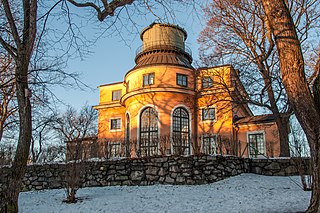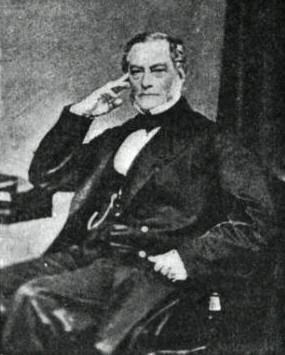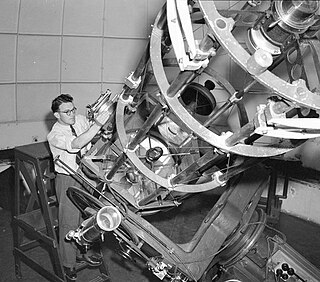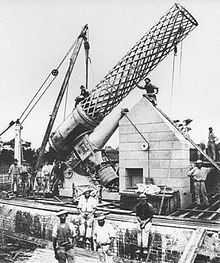
Yerkes Observatory is an astronomical observatory located in Williams Bay, Wisconsin, United States. The observatory was operated by the University of Chicago Department of Astronomy and Astrophysics from its founding in 1897 to 2018. Ownership was transferred to the non-profit Yerkes Future Foundation (YFF) in May 2020, which began restoration and renovation of the historic building and grounds. Re-opening for public tours and programming began May 27, 2022.

Speculum metal is a mixture of around two-thirds copper and one-third tin, making a white brittle alloy that can be polished to make a highly reflective surface. It was used historically to make different kinds of mirrors from personal grooming aids to optical devices until it was replaced by more modern materials such as metal-coated glass mirrors.

The Dominion Astrophysical Observatory, located on Observatory Hill, in Saanich, British Columbia, was completed in 1918 by the Canadian government. The Dominion architect responsible for the building was Edgar Lewis Horwood. The main instrument is the 72-inch-aperture (1.83 m) Plaskett telescope, proposed and designed by John S. Plaskett in 1910 with the support of the International Union for Cooperation in Solar Research.

The Isaac Newton Telescope or INT is a 2.54 m (100 in) optical telescope run by the Isaac Newton Group of Telescopes at Roque de los Muchachos Observatory on La Palma in the Canary Islands since 1984.

Siding Spring Observatory near Coonabarabran, New South Wales, Australia, part of the Research School of Astronomy & Astrophysics (RSAA) at the Australian National University (ANU), incorporates the Anglo-Australian Telescope along with a collection of other telescopes owned by the Australian National University, the University of New South Wales, and other institutions. The observatory is situated 1,165 metres (3,822 ft) above sea level in the Warrumbungle National Park on Mount Woorat, also known as Siding Spring Mountain. Siding Spring Observatory is owned by the Australian National University (ANU) and is part of the Mount Stromlo and Siding Spring Observatories research school.

Mount Stromlo Observatory located just outside Canberra, Australia, is part of the Research School of Astronomy and Astrophysics at the Australian National University (ANU).

The Stockholm Observatory is an astronomical observatory and institution in Stockholm, Sweden, founded in the 18th century and today part of Stockholm University. In 1931, the new Stockholm Observatory, nicknamed "Saltis", was inaugurated on the Karlsbaderberget at Saltsjöbaden, near Stockholm, and operated until 2001.

Hamburg Observatory is an astronomical observatory located in the Bergedorf borough of the city of Hamburg in northern Germany. It is owned and operated by the University of Hamburg, Germany since 1968, although it was founded in 1825 by the City of Hamburg and moved to its present location in 1912. It has operated telescopes at Bergedorf, at two previous locations in Hamburg, at other observatories around the world, and it has also supported space missions.

Melbourne Observatory is an observatory located on a hill adjacent to the Royal Botanic Gardens Victoria. The observatory commenced operations in 1862 and was decommissioned from official Government work in 1945. The observatory has since continued as an astronomical observatory and remains open to the public. Melbourne Observatory is also permanently on the Australian National Heritage List under 'Melbourne's Domain Parkland and Memorial Precinct' since early 2018.

Grubb Parsons was a historic manufacturer of telescopes, active in the 19th and 20th centuries. They built numerous large research telescopes, including several that were the largest in the world of their type.

Thomas Grubb was an Irish optician and founder of the Grubb Telescope Company.

The Crossley telescope is a 36-inch (910 mm) reflecting telescope located at Lick Observatory in the U.S. state of California. It was used between 1895 and 2010, and was donated to the observatory by Edward Crossley, its namesake.

Great refractor refers to a large telescope with a lens, usually the largest refractor at an observatory with an equatorial mount. The preeminence and success of this style in observational astronomy defines an era in modern telescopy in the 19th and early 20th century. Great refractors were large refracting telescopes using achromatic lenses. They were often the largest in the world, or largest in a region. Despite typical designs having smaller apertures than reflectors, great refractors offered a number of advantages and were popular for astronomy. It was also popular to exhibit large refractors at international exhibits, and examples of this include the Trophy Telescope at the 1851 Great Exhibition, and the Yerkes Great Refractor at the 1893 World's Fair in Chicago.

Sidney Charles Bartholemew "Ben" Gascoigne was a New Zealand-born optical astronomer and expert in photometry who played a leading role in the design and commissioning of Australia's largest optical telescope, the Anglo-Australian Telescope, which for a time was one of the world's most important astronomical facilities. Born in Napier, New Zealand, Gascoigne trained in Auckland and at the University of Bristol, before moving to Australia during World War II to work at the Commonwealth Solar Observatory at Mount Stromlo in Canberra. He became skillful in the design and manufacture of optical devices such as telescope elements.

The Astronomical Society of Victoria (ASV) is an amateur astronomy club in the state of Victoria, Australia. It was founded in 1922, making it one of the oldest such clubs in the country, and with some 1500 members it claims to be one of the largest amateur astronomy organisations in the southern hemisphere. Membership is open to all with an interest in astronomy, and the society caters for people with a wide range of ages, backgrounds, abilities and interests.

The Linden Observatory Complex is a heritage-listed former observatory and manufacture of optical precision implements and now residence, museum, observatory, education facility and meeting venue located at 91 – 111 Glossop Road, Linden, City of Blue Mountains, New South Wales, Australia. It was designed and built by Ken Beames from 1938 to 1948. It is also known as K Beames Engineering Co. The property is owned by the Linden Observatory Trust. It was added to the New South Wales State Heritage Register on 5 March 2010.

The Greenwich 28-inch refractor is a telescope at the Royal Observatory, Greenwich, where it was first installed in 1893. It is a 28-inch ( 71 cm) aperture objective lens telescope, otherwise known as a refractor, and was made by the telescope maker Sir Howard Grubb. The achromatic lens was made Grubb from Chance Brothers glass. The mounting is older however and dates to the 1850s, having been designed by Royal Observatory director George Airy and the firm Ransomes and Simms. The telescope is noted for its spherical dome which extends beyond the tower, nicknamed the "onion" dome. Another name for this telescope is "The Great Equatorial" which it shares with the building, which housed an older but smaller telescope previously.




















